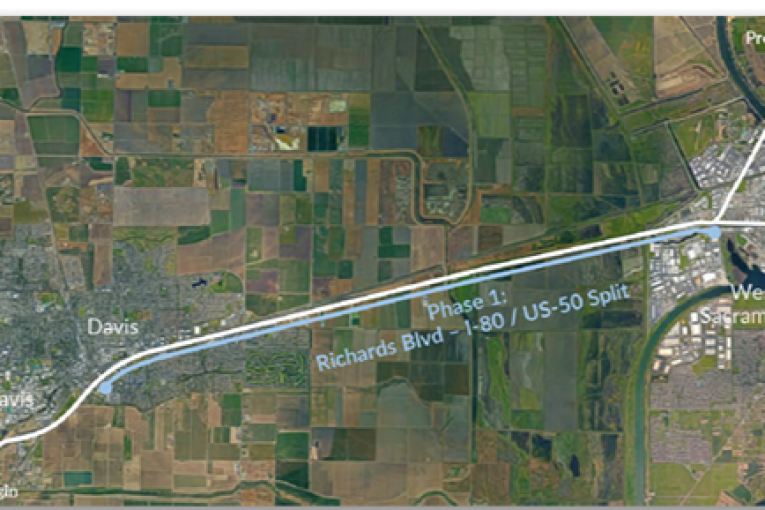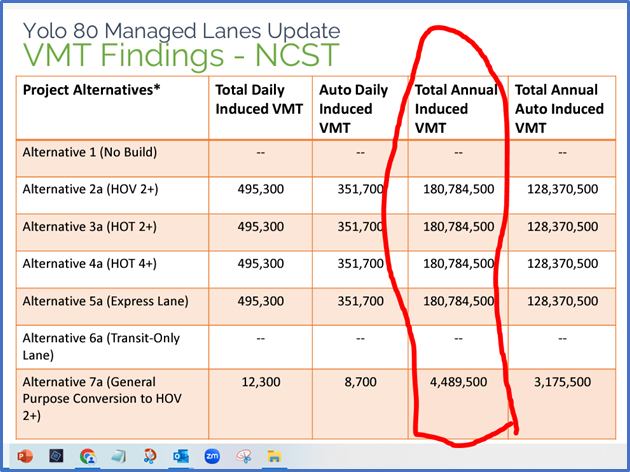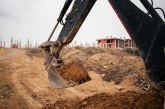

Accepting DEIR to get $86 million fed money for auto widening turns Climate Plan into carbon off set—and obligates YoloTD to find hundreds of millions more to complete and mitigate it.
By Alan Hirsch – Yolo Mobility
On the Tuesday January 9 council meeting there will be the first and maybe only discussion of DEIR—and alternative selection for I-80 widening,
This meeting will be interesting as both City staff and Councilperson Bapu Vaitla have written critical comment letters on many problems with the I-80 Draft EIR. The letters note incorrect forecasting of benefits and impact—and process problems. And a shortfall of funding for climate mitigation.
The City’ staff’s draft letter for council found here notes the following issues:
- An “inaccurate or incomplete project description.” This is so basic a violation of CEQA, by itself it can be the basis for a successful lawsuit.
- No description of phasing even for the initial $86million (i.e. Additional hundreds of millions needed).
- No information for public on how long construction will last—beyond 2029 when $86 Million runs out (best 1/3 of project).
- Missing a traffic safety analysis during construction.
- City requests study of additional alternates to widening.
- No review on how it affects City Climate action plan.
- The DEIR identifies eight “VMT Reduction Measures.” List but not included, with no explanation.
- VMT mitigation plan is estimated to cost $55 million a year, but not clear where this funding is coming from (tolls?), and questions if $55 million is sufficient.
- Mitigation requires buy in by other agencies that have not been obtained.
- No enforceability of mitigation plan if not funded/results not accomplished.
- DEIR contains contradictory information about modeling truck traffic induced demand.
- Missing a safety impact of elimination of center shoulder.
- Treats induced demand inconsistently in its forecasting.

 before a decision is made.
before a decision is made.A Contrast: YoloTD Board sees nothing wrong with DEIR—so they can use its flawed results to decide on an alternative.
In contrast with City of Davis staff letter, with YoloTD board was 100% OK with the DEIR “as is” at its December 11 YoloTD meeting (video, agenda), and they decide on the alternative 4—aka HOT3+— toll for everyone but free for 3+ in a car. Between the 5 board members there were only two questions on the actual DIER, and no one asked why staff suggestion an alternative polled poorly in the survey. No one noted that giving 3+ car tool free passage is unenforceable—it’s on the honor system per Autumn Berstein as stated (KDRT radio interview 1/6).
Most striking, the board asked not a single question on December 11 about if the project would fix “cut thru traffic” on Mace, or about traffic safety after elimination of the center shoulder or during construction.
I watched the meeting YoloTD meeting again, but video to confirm this.
One of only two DEIR questions was by UCD’s Matt Dulcich (video 1:16). It exposed that the mitigation funding chart in DEIR was misleading in that it hid the plan’s funding shortfall, but no one asked a follow up, or expressed concern about this. The board did not even ask for a side-by-side comparison of the different alternatives before making a choice. Strange, as the board developed a list of goals for the project at their December 2021 meeting.
Instead, they just voted staff recommendations for the $436 Million project after a 16 ½ minute discussion (1:32).
This problem with Caltrans Draft EIR also reflects on YoloTD staff. They have seen the administrative drafts of the EIR for at least 9 months but were unable, never noticed, or never asked Caltrans to make corrections to these issues the city of Davis and other have noticed. Possibly this is because YoloTD staff did not have support of its board when confronting Caltrans?
 YoloTD Board incurious of public input on I-80 & DEIR after massive outreach program.
YoloTD Board incurious of public input on I-80 & DEIR after massive outreach program.
It rather striking that YoloTD board had such a lack of interest in the actual DEIR—and especially curiosity based on substantive public comment. I had to relisten to the meeting to fully grasp the silent response when Davis Councilperson Bapu Vaitla and Urban Studies Professor Stephen Wheeler offer substantial and specific comments—and the Board did not follow up with any question to staff or Caltrans. (Watch Mtg video of Wheeler 0:56:00 Bapu 1:00:30. The full public comment begins 52:00 on video).
When this happens, one can’t help but be suspicious that the board made their decision ahead of time—out of public view.
This open and shut decision making contrasts with the big shows of taking public input that implied it would be thoughtfully considered in the decision-making process. Caltrans & YoloTD had well publicized outreach—even including TV, and they got over 1500 members public to take the time to give input and submit comment.
The first sign things were not as they seem on public input was to contrast the deadline for public input of January 5 (now 12), with the YoloTD board decision making four weeks before. This was even before the Davis DEIR Open house Dec 13. This may have been foreshadowed by YoloTD Director of Planning Brian Abbanat stating at his presentation on May 24, 2023 (to Breathe California) that regardless of the EIR finding he expected Caltrans would choose an auto-widening option and justify this by a finding of “overriding interest” regardless of climate and other impacts.
YoloTD board also seem incurious of written input solicited and received by Caltrans by that December 11—but not shared with the board.
And even the online survey was largely ignored even though 1500 people had taken it (I was at best an aside in the 16 1/2-minute board discussion before they voted). The board followed staff suggestion on the choice of alternatives even though it was not the highest polling one—and not one board member asked why this was. However, on the Davisville KDRT radio show YoloTD Executive Director Bernstein was asked about why the survey contradicted the staff recommendations. She responded staff decided YoloTD just needed to do the right thing.
Skeptics can wonder if this survey and outreach effort was performative—political cover for the YoloTD board by the staff to seem like they were listening.
As part providing deniability for their power in the process, YoloTD staff continues to insist the board is not the final decision maker under CEQA, but claim Caltrans is. While this is technically true, given that YoloTD board controls the purse strings on the $86 million, that is in fact a legal fiction. Watch both Davis’s Josh Chapman & Lucas Frerich’s interests gravitate to evidence their hands were tied and they had to decide that evening (1:26 in meeting video). More time was spent on this than whether the alternative chosen fixed “cut thru traffic.”
In fact, YoloTD staff admitted the Board can still intercede at a future meeting by blocking assigning the $86m funding by not filing a form called “FHWA Term Sheet.” The YoloTD timeline say this will happen in February, a time-before Caltrans make the “Official” decision on an alternative. However, no explanation of necessity was given or inquired about by the board about this.
Or more globally, YoloTD always retains political power to block future grants to complete the project.
YoloTD’s denial of the power they have hides their responsibility for this controversial project—and its climate impacts.
Public Can Influence the Project
The only conclusion one can make is the official DEIR public process has been largely a sham—apart from the potential of a lawsuit. The result was pre-decided 15 months ago. Climate change is worsening and Davis and other cities engaging hundreds of people to do a climate plan made no difference. Performative exercises. NJ Mvondo chair of Yolo County climate commission said her group was forbidden to review the project. The Davis Climate committee (the NRC) was given only a secondary role.
The most obvious citizen options are to try to pressure YoloTD board members to change its decision at its either its Monday January 22 or February 12 meeting—and to nix signing the “term sheet.” Until the EIR is finished to their satisfaction. A change.org petition to help with this has gone online.
But the public retains deeper options, political options, regardless of what YoloTD board, staff and Caltrans does. A strong showing of opposition at the Davis council meeting Jan 9 would be part of the process to block Caltrans getting the missing hundreds of millions of missing funding—as well as to send a message to Lucas Frerichs and Josh Chapman their behavior is noted in regard to public process (Chapman is up for reelection in Nov).
A strong letter from the Davis council to Caltrans with a request to recirculate the DEIR also strengthens a legal case filed if one is filed by the environmental community. Professor Wheeler has noted even the City of Davis could file or join a lawsuit to protect the city’s climate plan, based on an inadequate EIR analysis. Even if the extra lane is approved it might force the region to fund better transit service on the entire corridor—or force that the lane be used only for buses and trucks, if we are concern about interstate trade? Or assure the mitigation plan is funded.
Or maybe a lawsuit might give preference use of the lane to low wage workers & trucks going to/from jobs: tradesmen, farmers and construction workers? If we can give toll free preferences to 3+ plus car that favor the Tahoe traveler, why not other people? That seems more social equity than a transfer payment in form of free bus passes for Winters and Woodland residents.
Lessons for Davis & Yolo from M L King
In describing this, I want to be clear: unlike some places in the East, I do not believe anyone is getting pay offs or kickbacks for approving this widening. Rather, I believe members of YoloTD board care for their cities—the evidence of this is they are unpaid and essentially volunteer thousands of hours.
Rather, I believe they think cutting corners on the I-80 process is a necessary evil for all the best reasons, not intended to surface controversy and divisiveness.
This is just like in the 1960’s in the South. When ML King arrived in a town he was told by the progressive liberal whites, even some establishment blacks, to go away, don’t stir up a backlash and create divisiveness. “Yes,” they would say, “we believe in integration and civil rights for negroes, but we just aren’t ready yet. Give us time… ”
Like racial integration in 1960’s, YoloTD board does not feel our community is ready to deal make necessary changes necessary to deal with climate crisis.
The title of King’s famous book provided a response: Why We Can’t Wait.
Three Ways to Comment to Council Tuesday
Public can show up at Davis Council Meeting Tuesday to give input on and to ask for a critical review of the $436 Million project, especially by asking that Caltrans “recirculate the corrected DEIR as it is deeply flawed.
- In person at council chamber agenda -8pm agenda item : https://www.cityofdavis.org/city-hall/city-council/city-council-meetings/agendas Staff report (see City staff Draft letter to Caltrans which affirm below concerns ) https://documents.cityofdavis.org/Media/Default/Documents/PDF/CityCouncil/CouncilMeetings/Agendas/2024/2024-01-09/08-Yolo-80-Manged-Lanes-Draft-EIR.pdf
- Leave voice mail (12-4) on Tuesday JAN 9th: 530-757-5603 (2 minutes)
- Send a message to council: citycouncilmembers@cityofdavis.org
Issues with Caltrans Draft Environmental Impact Report
- The City/YoloTD needs to request Caltrans recirculate the DEIR after Caltrans corrects it and wait until after the public input period is closed—before they make a choice of alternatives. Not to do so invites a lawsuit and delay—and cynicism—about public process.
- Only for GHG—but Caltrans finally accepted UC Davis numbers about induced demand travel. 180 Million VMT Miles year equal 12K car or 15% of city GHG. Yet Caltrans has decided this was “insignificant” after just 43% mitigation (see 6 below).
- This addition to GHG/VMT travel is contra to State, County and Davis climate plans. This admission alone should be the end of discussion about “unavoidable impact” until Caltrans studies transit alternative-for the corridor to fix congestion and provide everyone a travel choice. Caltrans had underplayed its I-80 CMCP study that says upgrading Cap corridor trains to 100 mph is 15x more cost effective than freeway widening.
- NOT FIXED: The Caltrans traffic forecast model continues to overstate congestion relief from project as their modeling still does not include induced traffic. Thus, all the future travel time forecast by Caltrans remains incorrect. City staff say this…but excuse the model as “best we have now”. UC Davis researcher Amy Lee points out Caltrans has refused to update their models for induced demand. Should willful ignorance be used to justify negating the climate plan and spending $400+ mil—when transit alternatives not even considered?
- No discussion of cut thru traffic on Mace Blvd in DEIR. This project won’t fix it for long was the conclusion by Davis Transportation Commission.
- We don’t have the missing $200-$350 million to do the project: Just because we got starter $86 million is not reason to go ahead. Who is picking up the rest of the tab?
- The “mitigation plan” is to turn Davis VMT/GHG reduction climate plan into a carbon offset. They expect Davisites (and others in Yolo) to be driving less (via TDM & better bus service) so that Solano, Sac, and Bay area resident can drive more (180 Mil miles) on the wider freeway.
- Even this mitigation plan is just 43% of the GHG created. i.e., a setback for State, Local and City Climate Plan.
- The mitigation plan offset for 43% VMT is largely unfunded. The cost of shifting 10-14,000 rider to some form of transit is a $55/year. However, this likely only covers the operation costs, not cost of buses and rail vehicles. The VMT offset number they suggest they can create is equal to 4/5 of the entire ridership of RT light rail system- which cost billions to construct. The DEIR also lacks proof the toll lane revenue will fund the $55mil, especially when they are giving most Tahoe traffic a free pass.
- No transit alternatives for the 90% traveler on causeway who are not from Yolo County. No corridor wide transit improvement was studied in DEIR—from Berkeley Vallejo, Vacaville or even Dixon to Davis/Sac—were studied. Caltrans ignored one study (I-80 CMCP) that showed upgrading the cap corridor rail service to 100 MPH is 15x more cost effective.
- Caltrans DEIR outreach/open house was performative: They did not disclose the VMT increase and its GHG effect to those attending, They failed to even have a provide a fully copy of DEIR on site—or in the library next door. The library still does not have a full copy of the DEIR on their shelves.
- Favoring Tahoe Traffic: The Yolo Transportation Board voted to make the toll lane “free” for groups of 3 or more, thus favoring recreation travelers to Tahoe who are most likely to travel in groups. This policy would be unlikely to create any more carpooling (who would carpool to Tahoe to save a $10 toll?) but would shift the burden of paying to mitigate travel to local residents.
- It’s not social equity, it’s a transfer payment. YoloTD Board have said they would be using some of the toll revenue to give benefit to the poor as “social equity.” However, having poor and working class pay tolls, then giving a benefit to other poor folks is not social equity, it’s a transfer payment. With 90% of driving across causeway not from Yolo County, there has been no discussion of social equity/transfer payment benefit to these-out-of-county low toll lane users.
- Toll levels are not disclosed in DEIR. The toll levels anticipated were not disclosed in the DEIR. On the KDRT radio interview (1/6 KDRT interview) Autumn Bernstein expected toll at rush hours, when you need the lane, most would likely be on order $1 mile, or $13. It has not been analyzed if tolls this high this would incentivize folks to use Tremont/Mace when the other 3 lane are congested.





